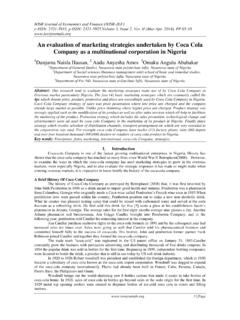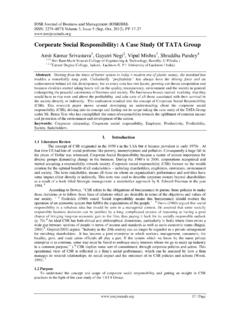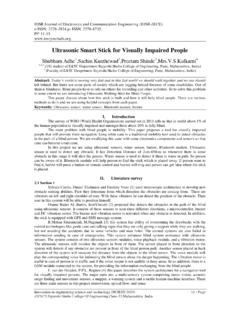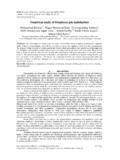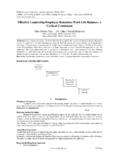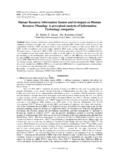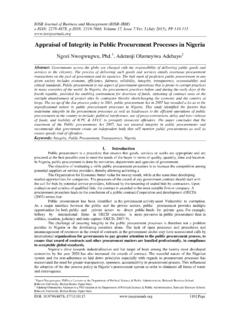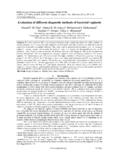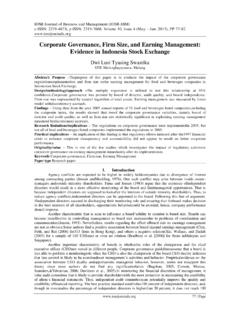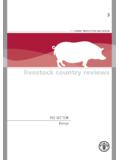Transcription of Extraction of Curcumin - IOSR Journals
1 IOSR Journal of Environmental Science, Toxicology and Food Technology (IOSR-JESTFT) ISSN: 2319-2402, ISBN: 2319-2399. Volume 1, Issue 3 (Sep-Oct. 2012), PP 01-16 1 | Page Extraction of Curcumin Anamika Bagchi (Department of Food Technology, Techno India/ West Bengal University of Technology, India) ABSTRACT : Curcumin due to its various medicinal, biological, pharmacological activities is high on demand and has high market potential, high cost. Since Curcumin has variety of uses, extracting it in a less expensive method other Super Critical Fluid Extraction is the main aim or objective of this work. Usage of food grade solvents is a main prerequisite of this work and optimization of the parameters in order to find an effective means of Extraction sum ups the cause of this project work. Besides working on the Extraction of Curcumin , other properties such as Curcumin s antioxidant, antimicrobial properties are to be envisaged upon.
2 This project work mainly deals with the topic on Extraction of Curcumin from its common source turmeric, using an effective low cost method of solvent Extraction . Different solvents are used either in their pure form or being mixed in definite ratio s, while taking into consideration of other parameters such as particle size, time, temperature, solid: solvent ratio. The qualitative analysis of its antimicrobial property is also done along with the product development of Cake. Keywords - Antiflatulent, Antifibrotic, Antimutagenic, Carcinogenesis, Ulcerogenic I. Introduction The turmeric (Curcuma longa) plant, a perennial herb belonging to the ginger family, is cultivated extensively in south and southeast tropical Asia. The rhizome of this plant is also referred to as the root and is the most useful part of the plant for culinary and medicinal purposes. The most active component of turmeric is Curcumin , which makes up 2 to 5% of the spice.
3 The characteristic yellow color of turmeric is due to the curcuminoids, first isolated by Vogel in 1842. Curcumin is an orange yellow crystalline powder practically insoluble in water. The structure of Curcumin (C 21 H 20 O 6) was first described in 1910 by Lampe and Milobedeska and shown to be diferuloylmethane. Turmeric is used as a dietary spice, coloring agent in foods and textiles, and a treatment for a wide variety of ailments. It is widely used in traditional Indian medicine to cure biliary disorders, anorexia, cough, diabetic wounds, hepatic disorders, rheumatism, and sinusitis. Turmeric paste in slaked lime is a popular home remedy for the treatment of inflammation and wounds. For centuries, Curcumin has been consumed as a dietary spice at doses up to 100 mg/d. Extensive investigation over the last five decades has indicated that Curcumin reduces blood cholesterol.
4 (Aggarwal et al., 2006).Turmeric was described as C. longa by Linnaeus and its taxonomic position is as follows: Class Liliopsida Subclass Commelinids Order Zingiberales Family Zingiberaceae Genus Curcuma Species Curcuma longa The wild turmeric is called C. aromatica and the domestic species is called C. longa. For the last few decades, extensive work has been done to establish the biological activities and pharmacological actions of turmeric and its extracts. Curcumin (diferuloylmethane), the main yellow bioactive component of turmeric has been shown to have a wide spectrum of biological actions. These include its anti-inflammatory, antioxidant, anticarcinogenic, antimutagenic, anticoagulant, antifertility, antidiabetic, antibacterial, antifungal, antiprotozoal, antiviral, antifibrotic, antivenom, antiulcer, hypotensive and hypocholesteremic activities. Its anticancer effect is mainly mediated through induction of apoptosis.
5 It s anti-inflammatory, anticancer and antioxidant roles may be clinically exploited to control rheumatism, carcinogenesis and oxidative stress-related pathogenesis. Clinically, Curcumin has already been used to reduce post-operative inflammation. Safety evaluation studies indicate that both turmeric and Curcumin are well tolerated at a very high dose without any toxic effects. Thus, both turmeric and Curcumin have the potential for the development of modern medicine for the treatment of various diseases. (Chattopadhyay et al., 2004) Chemical composition of turmeric Turmeric contains protein ( ), fat ( ), minerals ( ), carbohydrates ( ) and moisture ( ). The essential oil ( ) obtained by steam distillation of rhizomes has a-phellandrene (1%), sabinene ( ), cineol (1%), borneol ( ), zingiberene (25%) and sesquiterpines (53%)5. Curcumin Extraction of Curcumin 2 | Page (diferuloylmethane) (3 4%) is responsible for the yellow color, and comprises Curcumin I (94%), Curcumin II (6%) and Curcumin III ( )6.
6 Demethoxy and bisdemethoxy derivatives of Curcumin have also been isolated7 (Figure 1). Curcumin was first isolated in 1815 and its chemical structure was determined by Roughley and Whiting in 1973. It has a melting point at 176 177 C; forms a reddish-brown salt with alkali and is soluble in ethanol, alkali, ketone, acetic acid and chloroform. (Chattopadhyay et al., 2004) Curcumin (also known as Curcumin I) occurs naturally in the rhizome of Curcuma longa, which is grown commercially and sold as turmeric, a yellow orange dye. Turmeric contains Curcumin along with other chemical constituents known as the curcuminoids . The major curcuminoids present in turmeric are demethoxycurcumin ( Curcumin II), bisdemethoxycurcumin ( Curcumin III), and the recently identified cyclocurcumin. Commercial Curcumin contains Curcumin I (~77%), Curcumin II (~17%), and Curcumin III (~3%) as its major components.
7 The curcuminoid complex is also referred to as Indian saffron, yellow ginger, yellow root, kacha haldi, ukon, or natural yellow. Spectrophotometrically, Curcumin has a maximum absorption ( max ) in methanol at 430 nm, with a Beer s law range from to 5 g/mL (Prasad, 1997). It absorbs maximally at 415 to 420 nm in acetone and a 1% solution of Curcumin has 1650 absorbance units. Curcumin has a brilliant yellow hue at pH to 7 and takes on a red hue at pH > 7. The spectral and photochemical properties of Curcumin have been studied in different solvents by Chignell and coworkers. In toluene, the absorption spectrum of Curcumin contains some structure, which disappears in more polar solvents such as ethanol and acetonitrile. The fluorescence of Curcumin occurs as a broad band in acetonitrile ( max = 524 nm), ethanol ( max = 549 nm), or micellar solution ( max = 557 nm), but has some structure in toluene ( max = 460, 488 nm).
8 In addition, Curcumin was observed to produce singlet oxygen upon irradiation ( max > 400 nm) in toluene or acetonitrile (phi = for 50 M Curcumin ). Curcumin quenched singlet oxygen in acetonitrile (kq = 7 X 10 6 /M-s). Singlet oxygen production was about ten times lower in alcohols and was hardly detectable when Curcumin was solubilized in an aqueous micellar solution of Triton X-100. However, in sodium dodecyl sulfate solution, no singlet oxygen phosphorescence could be observed for those micelles containing Curcumin . Curcumin is also reported to be able to photogenerate superoxide in toluene and ethanol. (Aggarwal et al.,2006) Fig 1: Structure of natural curcuminoids. (Chattopadhyay et al., 2004) Extraction of Curcumin 3 | Page activity of turmeric and its compounds Turmeric powder, Curcumin and its derivatives and many other extracts from the rhizomes were found to be bioactive.
9 Turmeric powder has healing effect on both aseptic and septic wounds in rats and rabbits. It also shows adjuvant chemoprotection in experimental for stomach and oral cancer models of Swiss mice and Syrian golden hamsters. Curcumin also increases mucin secretion in rabbits. Curcumin , the ethanol extract of the rhizomes, sodium curcuminate, [feruloyl-(4-hydroxycinnamoyl)- methane] (FHM) and [bis-(4-hydroxycinnamoyl)- methane] (BHM) and their derivatives, have high anti-inflammatory activity against carrageen in induced rat paw oedema. Curcumin is also effective in formalin induced arthritis. Curcumin reduces intestinal gas formation and carbon tetrachloride and D-galactosamine induced glutamate oxaloacetate transaminase and glutamate pyruvate transaminase levels. It also increases bile secretion in anaesthetized dogs and rats, and elevates the activity of pancreatic lipase, amylase, trypsin and chymotrypsin.
10 Curcumin protects isoproterenol-induced myocardial infarction in rats. Curcumin , FHM and BHM also have anticoagulant activity. Curcumin and an ether extract of C. longa have hypolipemic action in rats24 and lower cholesterol, fatty acids and triglycerides in alcohol induced toxicity. Curcumin is also reported to have antibacterial, antiamoebic and antiHIV activities. Curcumin also shows antioxidant activity. It also shows antitumour and anticarcinogenic activities. The volatile oil of C. longa shows anti-inflammatory, antibacterial and antifungal activities. The petroleum ether extract of C. longa is reported to have anti-inflammatory activity. Petroleum ether and aqueous extracts have 100% antifertility effects in rats. Fifty per cent ethanolic extract of C. longa shows hypolipemic action in rats. Ethanolic extract also possesses antitumour activity. Alcoholic extract and sodium curcuminate can also offer antibacterial activity.
